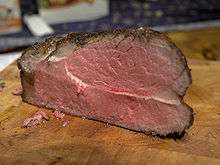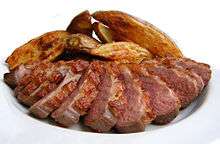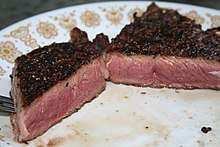Red meat
In gastronomy, red meat is commonly red when raw and a dark color after it is cooked, in contrast to white meat, which is pale in color before and after cooking.[1][2] In culinary terms, only flesh from mammals or fowl (not fish) is classified as red or white.[3][4] In nutritional science, red meat is defined as any meat that has more of the protein myoglobin than white meat. White meat is defined as non-dark meat from fish or chicken (excluding the leg or thigh). The health effects of red meat are unclear as of 2019.[5] Some meat, such as pork, is classified as white meat under the common or gastronomic definition, but as red meat under the nutritional definition.


Definition
| Name | Myoglobin | USDA category |
|---|---|---|
| Chicken breast | 0.005%[6] | White meat [7] |
| Chicken thigh | 0.18 - 0.20%[6] | Dark meat |
| Turkey thigh | 0.25 - 0.30%[6] | Dark meat |
| Pork | 0.10 - 0.30%[6] | Red meat[7] |
| Veal | 0.10 - 0.30%[6] | Red meat[7] |
| Beef | 0.40 - 1.00%[6] | Red meat[7] |
| Old beef | 1.50 - 2.00%[6] | Red meat[7] |

Under the culinary definition, the meat from adult or "gamey" mammals (for example, beef, horse meat, mutton, venison, boar, hare) is red meat, while that from young mammals (rabbit, veal, lamb) is white. Poultry is white, as well as duck and goose. Most cuts of pork are red, others are white.[8] Game is sometimes put in a separate category altogether. (French: viandes noires — "dark meats".)[4] Some meats (lamb, pork) are classified differently by different writers.
According to the United States Department of Agriculture (USDA), all meats obtained from mammals (regardless of cut or age) are red meats because they contain more myoglobin than fish or white meat (but not necessarily dark meat)[6] from chicken.[7] Some cuts of pork are considered white under the culinary definition, but all pork is red in nutritional studies. The National Pork Board has positioned it as "the other white meat", profiting from the ambiguity to suggest that pork has the nutritional properties of white meat, which is considered more healthful.[9][10]
Nutrition
Red meat contains large amounts of iron, creatine, minerals such as zinc and phosphorus, and B-vitamins: (niacin, vitamin B12, thiamin and riboflavin).[13] Red meat is a source of lipoic acid.
Red meat contains small amounts of vitamin D.[14] The liver contains much higher quantities than other parts of the animal.
In 2011, the USDA launched MyPlate, which did not distinguish between kinds of meat, but did recommend eating at least 8 oz (227 grams) of fish each week.[15][16] In 2011, the Harvard School of Public Health launched the Healthy Eating Plate in part because of the perceived inadequacies of the USDA's recommendations.[15] The Healthy Eating Plate encourages consumers to avoid processed meat and limit red meat consumption to twice a week because of links to heart disease, diabetes, and colon cancer. To replace these meats it recommends consuming fish, poultry, beans or nuts.[15]
Health effects
The health effects of red meat are unclear as of 2019.[5] Understanding the health impact of red meat is difficult because it is not a uniform product, with effects varying based on fat content, processing and preparation. One analysis showed that processed red meat is linked to slightly higher mortality, mainly due to cardiovascular diseases and cancer.[17]
Processed meat
In 2015, the International Agency for Research on Cancer of the World Health Organization (WHO) classified processed meat (bacon, ham, hot dogs, sausages) as carcinogenic to humans (Group 1), based on "sufficient evidence in humans that the consumption of processed meat causes colorectal cancer."[18]
Most processed meat contains at least some red meat.[19] To enhance flavor or improve preservation meat is treated by salting, curing, fermentation, smoking, or other processes to create processed meat.[19] Nitrates and nitrites found in processed meat (e.g. bacon, ham, salami, pepperoni, hot dogs, and some sausages) can be converted by the human body into nitrosamines that can be carcinogenic, causing mutation in the colorectal cell line, thereby causing tumorigenesis and eventually leading to cancer.[20] In its Press Release 240 (16 Oct. 2015) the International Agency for Research on Cancer, based on a review of 800 studies over 20 years, concluded that processed meat is definitely carcinogenic (Group 1) and found that for each additional 50g of processed meat consumed per day, the risk of colorectal cancer increased by 18% (up to a maximum of approximately 140g);[21] it also found that there appeared to be an increase in gastric cancer but this was not as clear.[22]
A 2016 literature review found that for the each additional 50g per day of processed meat (e.g., bacon, ham, hot dogs, sausages) consumed, the risk increased 4% for total prostate cancer, 8% for cancer mortality, 9% for breast cancer, 18% for colorectal cancer, 19% for pancreatic cancer, 13% for stroke, 24% for cardiovascular mortality and 32% for diabetes.[23]
Red meat
In 2015 the International Agency for Research on Cancer concluded that red meat is probably (Group 2A) carcinogenic to humans[19].
Studies that differentiate between processed and fresh red meat have failed to find a link between unprocessed red meat consumption and heart disease. A meta-analysis published in 2010 involving around one million people who ate meat found that only processed meat had an adverse risk in relation to coronary heart disease (CHD).[24] The review suggested that the "differences in salt and preservatives, rather than fats, might explain the higher risk of heart disease and diabetes seen with processed meats, but not with unprocessed red meats."[24]
Several studies have found a correlation between unprocessed red meat and the occurrence of CHD and certain types of stroke and have controlled for various confounding risk factors.[25] A study of 84,000 women, over a period of 26 years, finds that those with the highest intake of unprocessed red meat have a 13% increased risk of CHD.[25]
Unprocessed red meat intake is tentatively associated with an increased risk of type II diabetes, but the link is weaker and less certain than the link between processed red meat and diabetes.[26] Other findings have suggested that the association may be due to saturated fat, trans fat and dietary cholesterol, rather than red meat per se.[27]
Cancer
- In 2015, the International Agency for Research on Cancer of the World Health Organization (WHO) classified red meat as "probably carcinogenic to humans (Group 2A), based on limited evidence that the consumption of red meat causes cancer in humans and strong mechanistic evidence supporting a carcinogenic effect."[28]
- A 2011 study reported that for each additional 100g (up to a maximum of approximately 140g)[21] of red meat consumed per day, the risk of colorectal cancer increased by 17%; there also appeared to be increased risk of pancreatic cancer and prostate cancer but the association was not as clear.[22] Put in perspective, in the UK, 56 out of 1000 people who eat the lowest amount of red meat will develop colorectal cancer (5.6%) while 66 out of 1000 high-red meat eaters will develop colorectal cancer (6.6%) (1.17 x 5.6 = 6.6).[29]
- A 2012 meta-analysis found an increased risk of gastric cancer with higher consumption of red or processed meat.[30] Red meat itself contains certain factors that, under certain conditions, produce carcinogens like N-nitroso compounds (NOCs).[31]
- A 2016 literature review reported that for 100g or more per day of red meat consumed, the risk increased 11% for each of stroke and for breast cancer, 15% for cardiovascular mortality, 17% for colorectal cancer, and 19% for advanced prostate cancer.[23]
- A 2017 review indicated there are numerous potential carcinogens of colorectal tissue in red meat, particularly those in processed red meat products, such as N-nitroso compounds, polycyclic aromatic hydrocarbons, and heterocyclic amines.[32]
Cardiovascular disease and diabetes
A 2017 systematic review and meta-analysis of clinical research on stroke outcomes associated with meat consumption showed that total meat consumption, red meat consumption, and processed red meat consumption increased the risk of stroke by 18%, 11%, and 17%, respectively, while consuming white meat (chicken) reduced the risk of stroke by 13%.[33] Factors associated with increased stroke risk from consuming red meat include saturated fats that increase levels of blood cholesterol, LDL cholesterol, triglycerides, and heme iron, which may precipitate atherogenesis in cerebral arteries, leading to stroke.[33]
A 2017 review found that consuming a one-half serving of red meat daily was not associated with cardiovascular disease risk factors, such as total cholesterol, LDL, and hypertension.[34] One study estimated that “substitutions of one serving of nuts, low-fat dairy, and whole grains per day for one serving of red meat per day were associated with a 16–35% lower risk of type 2 diabetes”.[35]
Red meat consumption has been associated with higher fasting glucose and insulin concentrations, which are risk factors for type 2 diabetes.[36] Daily consumption of 85 grams of red meat and 35 grams of processed red meat products by European and American consumers increased their risk of type 2 diabetes by 18-36%, while a diet of abstinence of red meat consuming whole grains, vegetables, fruits, and dairy was associated with an 81% reduced risk of diabetes.[37]
Cooking

Cooking any meat at a high temperature or smoking meat produces carcinogenic polycyclic aromatic hydrocarbon compounds (PAHs) and heterocyclic amines (HCAs).[38] The subgroups of heterocyclic amines compounds are amino-dimethylimidazo-quinoxaline (MelQx), amino-dimethylimidazo-quinoxaline (DiMelQx), and amino-methyl-phenylimidazo-pyridine (PhIP), which are mostly formed when meat is cooked at high temperatures. Benzo[a]pyrene (B[a]P) is another compound found in meat cooked at extremely high temperatures. Likely because of these factors, marinating fresh lean red meat and thoroughly cooking it at a low temperature will reduce the production of carcinogenic compounds and thereby lower the risk of colorectal cancer.[39][40]
See also
- White meat
References
- "Red Meat". thefreedictionary.com.
- "White Meat". thefreedictionary.com.
- "Color Confusion: Identifying Red Meat and White Meat". 2013-01-02. Archived from the original on 2016-12-30. Retrieved 2017-04-29.
- Larousse Gastronomique, first edition
- Johnston, Bradley C.; Zeraatkar, Dena; Han, Mi Ah; et al. (1 October 2019). "Unprocessed Red Meat and Processed Meat Consumption: Dietary Guideline Recommendations From the Nutritional Recommendations (NutriRECS) Consortium". Annals of Internal Medicine. 171: 756. doi:10.7326/M19-1621. PMID 31569235.
- "Iowa State Animal Science". Archived from the original on 2009-03-24. Retrieved 2009-09-16.
- "USDA-Safety of Fresh Pork...from Farm to Table". Fsis.usda.gov. 2008-05-16. Archived from the original on 2013-09-18. Retrieved 2009-09-16.
- Larousse Gastronomique, 1961, s.v. pork
- Dougherty, Philip H. "ADVERTISING; Dressing Pork for Success" Archived 2017-02-14 at the Wayback Machine, The New York Times, January 15, 1987. Accessed April 22, 2009.
- Hall, Trish. "And This Little Piggy Is Now on the Menu" Archived 2017-02-14 at the Wayback Machine, The New York Times, November 13, 1991. Accessed April 22, 2009.
- Smil, Vaclav (2002). "Eating Meat: Evolution, Patterns, and Consequences". Population and Development Review. 28 (4): 599–639. doi:10.1111/j.1728-4457.2002.00599.x. JSTOR 3092782.
- "USDA ERS - Per Capita Red Meat and Poultry Disappearance: Insights Into Its Steady Growth". www.ers.usda.gov. Retrieved 2018-12-03.
- Kansas State University Agricultural Experiment Station and Cooperative Extension Service, Red Meats: Nutrient Contributions to the Diet, September 20 BC, Archived September 12, 2006, at the Wayback Machine
- Nutritional composition of red meat Archived 2011-03-10 at the Wayback Machine
- Harvard School of Public Health, 2012. Food Pyramids: What Should You Really Eat Archived 2009-04-16 at the Wayback Machine
- USDA MyPlate Protein foods Archived 2013-01-16 at the Wayback Machine Page accessed February 27, 2015
- Sabine Rohrmann; Kim Overvad; European Prospective Investigation into Cancer and Nutrition; et al. (7 March 2013). "Meat consumption and mortality – results from the European Prospective Investigation into Cancer and Nutrition". BMC Medicine. 11 (1): 63. doi:10.1186/1741-7015-11-63. PMC 3599112. PMID 23497300.
The results of our analysis support a moderate positive association between processed meat consumption and mortality, in particular due to cardiovascular diseases, but also to cancer.
- "Q&A on the carcinogenicity of the consumption of red meat and processed meat". World Health Organization. 1 October 2015. Retrieved 7 August 2019.
- International Agency for Research on Cancer (26 October 2015), IARC Monographs evaluate consumption of red meat and processed meat (PDF), archived (PDF) from the original on 10 November 2015
- Raphaëlle, Santarelli (2008). "Processed Meat and Colorectal Cancer: A Review of Epidemiologic and Experimental Evidence". Nutrition and Cancer. 60 (2): 131–144. doi:10.1080/01635580701684872. PMC 2661797. PMID 18444144.
- Chan, DS; Lau, R; Aune, D; Vieira, R; Greenwood, DC; Kampman, E; Norat, T (2011-06-06). "Red and processed meat and colorectal cancer incidence: meta-analysis of prospective studies". PLOS ONE. 6 (6): e20456. Bibcode:2011PLoSO...620456C. doi:10.1371/journal.pone.0020456. PMC 3108955. PMID 21674008.
In non-linear models, colorectal cancer risk appears to increase almost linearly with increasing intake of red and processed meats up to approximately 140 g/day. Above this level, the risk increase is less pronounced..
- Bouvard, V; International Agency for Research on Cancer Monograph Working Group.; et al. (December 2015). "Carcinogenicity of consumption of red and processed meat" (PDF). The Lancet. Oncology. 16 (16): 1599–600. doi:10.1016/s1470-2045(15)00444-1. PMID 26514947.
- Wolk, A (6 September 2016). "Potential health hazards of eating red meat". Journal of Internal Medicine. 281 (2): 106–122. doi:10.1111/joim.12543. PMID 27597529.
- Micha, R.; Wallace, S. K.; Mozaffarian, D. (1 June 2010). "Red and Processed Meat Consumption and Risk of Incident Coronary Heart Disease, Stroke, and Diabetes Mellitus: A Systematic Review and Meta-Analysis". Circulation. 121 (21): 2271–2283. doi:10.1161/CIRCULATIONAHA.109.924977. PMC 2885952. PMID 20479151.
- TH, Leung (2012). "Red Meat Consumption: The Good and the Bad" (PDF). Non-Communicable Diseases Watch. 5: 1–7. Archived (PDF) from the original on 2015-12-30.
- Micha, Renata; Michas, Georgios; Mozaffarian, Dariush (22 September 2012). "Unprocessed Red and Processed Meats and Risk of Coronary Artery Disease and Type 2 Diabetes – An Updated Review of the Evidence". Current Atherosclerosis Reports. 14 (6): 515–524. doi:10.1007/s11883-012-0282-8. PMC 3483430. PMID 23001745.
- Hu, F. B.; Van Dam, S.; Liu, R. M. (2001). "Diet and risk of Type II diabetes: the role of types of fat and carbohydrate". Diabetologia. 44 (7): 805–817. doi:10.1007/s001250100547. PMID 11508264.
- "Press release: IARC monographs evaluate consumption of red meat and processed meat" (PDF). International Agency for Research on Cancer, World Health Organization. 15 October 2015. Retrieved 26 October 2015.
- "Processed meat and cancer – what you need to know". Cancer Research UK - Science blog. Archived from the original on 2017-01-09. Retrieved 2016-12-29.
- Zhu, H; et al. (2013). "Red and processed meat intake is associated with higher gastric cancer risk: a meta-analysis of epidemiological observational studies". PLOS ONE. 8 (8): e70955. Bibcode:2013PLoSO...870955Z. doi:10.1371/journal.pone.0070955. PMC 3743884. PMID 23967140.
- "Inherited Bowel Cancer". geneticseducation.nhs.uk. Archived from the original on 2014-12-25.
- Jeyakumar, Arunan; Dissabandara, Lakal; Gopalan, Vinod (1 April 2017). "A critical overview on the biological and molecular features of red and processed meat in colorectal carcinogenesis". Journal of Gastroenterology. 52 (4): 407–418. doi:10.1007/s00535-016-1294-x. ISSN 0944-1174. PMID 27913919.
- Kim, Kyuwoong; Hyeon, Junghyeon; Lee, Sang Ah; Kwon, Sung Ok; Lee, Hyejin; Keum, NaNa; Lee, Jong‐Koo; Park, Sang Min (2017-09-22). "Role of total, red, processed, and white meat consumption in stroke incidence and mortality: A systematic review and meta‐analysis of prospective cohort studies". Journal of the American Heart Association. 6 (9): e005983. doi:10.1161/jaha.117.005983. ISSN 2047-9980. PMC 5634267. PMID 28855166.
- O'Connor, LE; Kim, JE; Campbell, WW (January 2017). "Total red meat intake of ≥0.5 servings/d does not negatively influence cardiovascular disease risk factors: a systemically searched meta-analysis of randomized controlled trials". American Journal of Clinical Nutrition. 105 (1): 57–69. doi:10.3945/ajcn.116.142521. PMC 5183733. PMID 27881394.
- Pan, A.; Sun, Q.; Bernstein, A. M.; Schulze, M. B.; Manson, J. E.; Willett, W. C.; Hu, F. B. (2011). "Red meat consumption and risk of type 2 diabetes: 3 cohorts of US adults and an updated meta-analysis". American Journal of Clinical Nutrition. 94 (4): 1088–1096. doi:10.3945/ajcn.111.018978. PMC 3173026. PMID 21831992.
- Fretts, Amanda (November 2015). "Consumption of meat is associated with higher fasting glucose and insulin concentrations regardless of glucose and insulin genetic risk scores: a meta-analysis of 50,345 Caucasians". American Journal of Clinical Nutrition. 102 (5): 1266–78. doi:10.3945/ajcn.114.101238. PMC 4625584. PMID 26354543.
- Schwingshackl, Lukas; Hoffmann, Georg; Lampousi, Anna-Maria; Knüppel, Sven; Iqbal, Khalid; Schwedhelm, Carolina; Bechthold, Angela; Schlesinger, Sabrina; Boeing, Heiner (2017-04-10). "Food groups and risk of type 2 diabetes mellitus: a systematic review and meta-analysis of prospective studies". European Journal of Epidemiology. 32 (5): 363–375. doi:10.1007/s10654-017-0246-y. ISSN 0393-2990. PMC 5506108. PMID 28397016.
- "Chemicals in Meat Cooked at High Temperatures and Cancer Risk". National Cancer Institute. 2018. Archived from the original on 2011-11-06.
- "Marinades Reduce Heterocyclic Amines from Primitive Food Preparation Techniques". Schor J. Archived from the original on 2014-12-25.
- "Seer Stat Fact Sheets: Colon and Rectum Cancer". Seer.cancer.gov. National Cancer Institute. Archived from the original on 2014-06-24.

